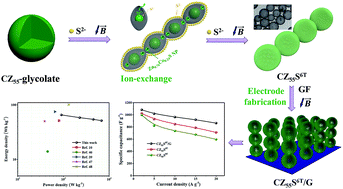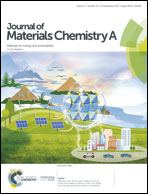Strong magnetic field-dual-assisted fabrication of heterogeneous sulfide-based hollow nanochain electrodes for high-rate supercapacitors†
Abstract
Many sulfide-based supercapacitors suffer from the problem of large capacity and energy attenuation at high rates. To tackle this problem, a strong magnetic field (SMF) was exerted twice during new material synthesis and electrode fabrication. Here, one-dimensional (1D) hetero-Zn0.76Co0.24S/Co3S4/β-CoS1.097 hollow sphere nanochains (CZ55S6T) were first prepared via a one-step anion-exchange reaction under SMF. The SMF-induced directional growth of paramagnetic Zn0.76Co0.24S in the outer shell contributed to the directional assembly of the simultaneously hollowing-out spheres into 1D nanochains based on the Kirkendall effect accelerated by SMF. Physicochemical investigations revealed that SMF endowed CZ55S6T with a larger surface area and reduced the loss of active components, especially Zn. The unique 1D hollow nanochain nanostructures contributed to a remarkable rate performance. An oriented CZ55S6T nanochains/graphene flake capacitive electrode (CZ55S6T/G) with high loading (∼8 mg cm−2) was further fabricated using SMF to reduce the path tortuosity. The CZ55S6T/G electrode exhibited strikingly enhanced rate capability with 80% capacitance retention (863.8 F g−1) and cycling capacitance (705 F g−1 after 5000 cycles) at a high rate of 20 A g−1. Furthermore, the CZ55S6T/G-based asymmetric supercapacitor delivered remarkable energy density of 51.5 W h kg−1 at a large power density of 6811 W kg−1.



 Please wait while we load your content...
Please wait while we load your content...